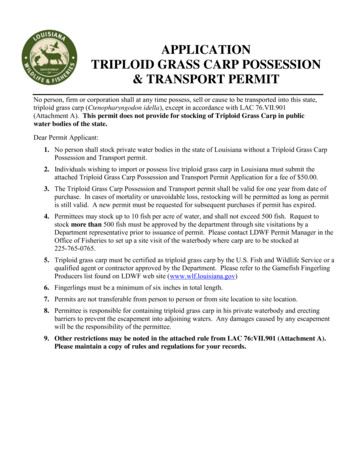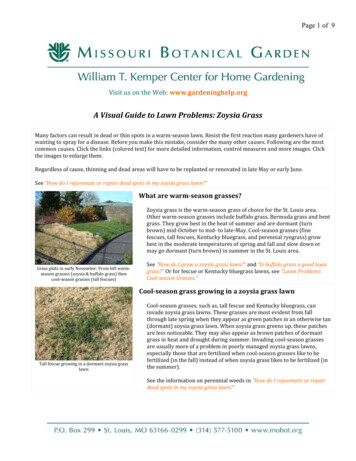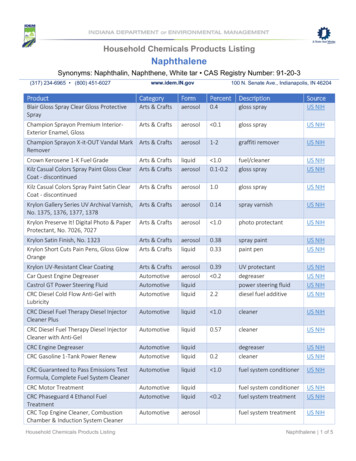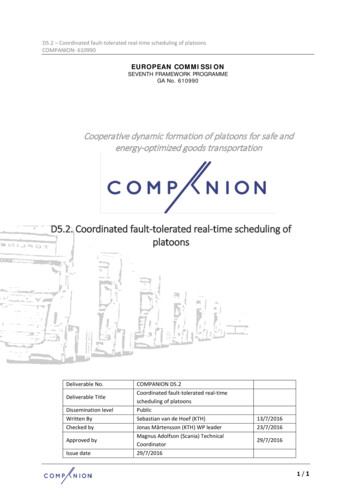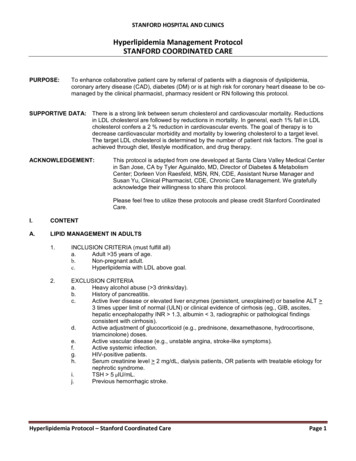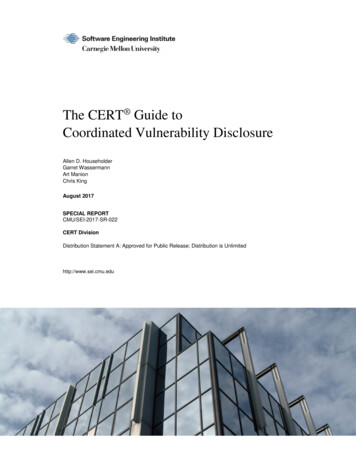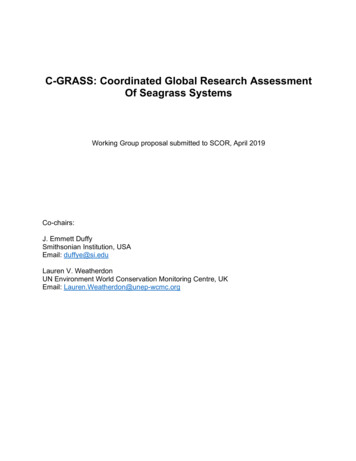
Transcription
C-GRASS: Coordinated Global Research AssessmentOf Seagrass SystemsWorking Group proposal submitted to SCOR, April 2019Co-chairs:J. Emmett DuffySmithsonian Institution, USAEmail: duffye@si.eduLauren V. WeatherdonUN Environment World Conservation Monitoring Centre, UKEmail: Lauren.Weatherdon@unep-wcmc.org
1. SummarySeagrasses provide the foundation of submerged coastal grassland ecosystems around the worldbut are threatened by human activities, with substantial declines in global cover over the lastcentury. Seagrasses provide multiple valuable ecosystem services, particularly in the developingworld. Yet obtaining an accurate understanding of seagrass status, trends, and responses to globalchange has been challenging due to the fragmented nature of available data. The time isopportune to solve these problems. Building on a recently completed Community White Paperand initial workshops to organize global seagrass researchers, we propose a series of SCORworkshops to collate and analyze existing data toward a scientific synthesis of the drivers andtrajectories of seagrass ecosystems under global change, and to provide a framework for futurecoordinated observation and research on seagrass systems. Our Working Group (WG) engages adiverse community, spanning the globe and fields of technical expertise to: (1) collate andanalyze existing data to publish an open-access scientific synthesis of current status, trends, anddrivers of change in global seagrass systems; (2) establish common protocols and best practicesfor seagrass data collection, curation, and sharing, collated in a multi-media handbook ofaccepted protocols and best practices; (3) integrate seagrass data collection into international,open-access portals, with common frameworks for data vocabulary, metadata, management, andservice to stakeholders; and (4) integrate ongoing seagrass monitoring and research into a globalcommunity of practice that incorporates diverse data types and informs diverse end users.2. Scientific Background and Rationale2.1. Global status of seagrass ecosystemsSeagrasses provide the foundation of submerged coastal grassland ecosystems around the world.They are among the most productive natural habitats on land or sea (1), store substantialquantities of carbon, and provide humanity with fishery habitat, coastal protection, erosioncontrol, and other services (2). Seagrass nutrient cycling services alone have an estimated valueof nearly 2 trillion per year (3), and Indonesian seagrass meadows provide fishery nursery areasthat contribute an estimated 54% to 99% of daily protein intake for local communities (4).Seagrasses also serve as early warning indicators of anthropogenic perturbations in the coastalzone due to their sensitivity to changing water quality and fishing activities (5).Seagrass habitats are threatened worldwide by human activities: a recent synthesis estimates thatalmost 30% of seagrass global cover has been lost over the last century (6) and 22 of the world’s72 seagrass species (31%) are in decline (2, 7), a trend widely considered a global crisis (8).Recognizing this, the Global Ocean Observing System (GOOS) has proposed seagrass cover andcomposition as one of seven Essential Ocean Variables (EOVs) defined by societal importanceas reflected in reporting requirements for numerous international conventions and agreementsthat shape policy responses to global change (9).Despite their importance, developing coordinated systems for observing seagrass status andtrends has been challenging for several reasons. First is the fragmented nature of available in situdata. Data on seagrass systems are collected by numerous local and regional monitoringSCOR Working Group proposal 2019: C-GRASS2
programs, and by two global programs: Seagrass-Watch (10, 11), SeagrassNet (12). Thesenetworks, together with the Smithsonian’s newer MarineGEO program, have engaged hundredsof scientists and thousands of citizens in collecting data. But such programs often have differentobjectives, methods, and target variables, making inter-comparison and synthesis difficult. Asecond challenge is that field sampling is biased geographically, concentrated in North Americaand western Europe around major scientific organizations. As a result, syntheses of seagrassoccurrence rely heavily on interpolation of expert knowledge and low-resolution point-basedoccurrence sampling, whereas seagrass extent is difficult to quantify and resolution is low in theregions where seagrasses are most diverse such as the western Pacific.2.2. New opportunities in seagrass science and conservationWe are now poised to overcome these historical challenges, as illustrated by several recentdevelopments. These include production of a consensus Community White Paper outliningcriteria for a coordinated global seagrass observing system (13), convening of the InternationalSeagrass Experts Network (ISEN)1, an upcoming GOOS workshop to draft implementation plansfor seagrass and mangrove observing, and participation in this WG of leaders of the two majorglobal seagrass networks, Seagrass-Watch (WG member McKenzie) and SeagrassNet (WGmember Short). Recent field initiatives have focused on seagrasses in the rich and understudiedterritories of southeast Asia and the coral triangle, including by members of this Working Group:Ambo-Rappe, Cullen-Unsworth, Fortes, Nordlund, Prathep, and Unsworth. While Africaremains poorly documented, WG member Uku is an authority in that region. This work promisesto significantly expand geographic coverage of seagrass knowledge in understudied areas.Additional opportunities to assemble a geographically comprehensive and well resolvedunderstanding of global seagrass systems come from innovations in remote sensing; engagementof citizen scientists in field data collection; and community consensus around the need forstandardization of protocols and data management (13). Our proposed working group (WG) aimsto integrate and coordinate remote sensing and in situ sampling programs toward a morepowerful scientific synthesis of global seagrass distribution and ecosystem characteristics. TheWG will then extend this synthesis by coordinating seagrass ecosystem researchers worldwidetoward consensus on comparable approaches for collecting and organizing data on seagrasscover, composition, and ecosystem characteristics. The WG will have the secondary benefit ofproviding a scientific and operational foundation to advance seagrass cover and composition asan Essential Ocean Variable (1).2.3. Rationale for a SCOR working groupWe propose a series of SCOR workshops that engage a diverse community of scientists andstakeholders to achieve the following goals: (1) collate and analyze data to produce a synthesisof the current status, trends, and drivers of change in global seagrass systems; (2) establishcommon protocols and best practices for seagrass data collection, curation, and sharing; (3)integrate existing and ongoing seagrass data collection into open-access portals, using a commonschema; and (4) integrate existing seagrass monitoring and analysis into a unified, global1See: http://unseagrass.org/SCOR Working Group proposal 2019: C-GRASS3
community of practice. The proposed workshops will establish the community to continue theprocess into the future, and several participating institutions are committed to supportingachievement of the long-term goals.Over the last few years seagrass researchers around the world have recognized the need for amore coordinated global response to understanding and publicizing seagrass degradation andhave begun to coalesce around a shared vision for achieving this (8, 13). The time is ripe for anew global assessment of seagrass ecosystems. Achieving such a synthesis requires engagingexpertise in seagrass physiology, field ecology, biogeochemistry, remote sensing, databasearchitecture, geospatial science and mapping, social science, and digital knowledge productdevelopment and service. The proposed WG, and our large network of collaborators, spans thisexpertise. Foundations have been laid by incorporating seagrass cover as an Essential OceanVariable by the Global Ocean Observing System (9), engaging the global community in theconsensus Community White Paper (13), and formation of the ISEN.The primary bottlenecks to a global seagrass database are comparability of protocols andaccessibility of data. We will make rapid progress on the first of these as leaders of both majorseagrass networks and the MarineGEO program are full members of this group (McKenzie,Short, Duffy). An achievable first step is to establish a public metadata portal to summarize whatseagrass data exist and who holds them. We will then work to make as much of this data aspossible accessible and will incorporate new data as they become available.Candidate protocols and best practices have been developed, vetted, and formalized by SeagrassWatch, SeagrassNet, the Zostera Experimental Network (14), MarineGEO2, and other programs,providing a foundation for a global community of practice. Under the right conditions, satelliteremote sensing (15) and lightweight drone technology (16) can obtain high-resolution maps ofseagrass distribution and resolve variation in abundance, offering promise in linking regional andglobal-scale cover mapping, and validating these with strategically sited in situ measurements.We will evaluate the capabilities of remote sensing to conduct regional assessments on the healthand cover of seagrass communities. Satellite images collected over the past 30 years provide anbasis for evaluating change, yet it is not clear how this technology can be leveraged with newunmanned airborne systems and field efforts. WG Members Muller-Karger and Dierssen bringexperience in these areas to the WG.The accessibility of shallow-water seagrass meadows and their importance to local fisheries andecosystems makes seagrass systems prime targets for application of citizen science monitoring,as done by Seagrass-Watch and the Seagrass Spotter phone app3, co-developed by WG MemberUnsworth. There is considerable potential to expand and integrate these activities. Through allthese approaches, we are poised to achieve a previously unavailable synthesis of the changingdistribution of global seagrass habitat, and the drivers of these trends. This process will alsoadvance implementation of the seagrass EOV envisioned as part of GOOS.23Available at: https://marinegeo.github.io/seagrass.htmlAvailable at: https://seagrassspotter.org/SCOR Working Group proposal 2019: C-GRASS4
3. Terms of ReferenceThe objectives of the SCOR C-GRASS Working Group are:Objective 1: Produce a scientific synthesis of status and trends in global seagrasses and thesystems they support, via a comprehensive review of peer-reviewed and gray literature, andunpublished data, on seagrass occurrence, ecosystem characteristics, and benefits to human wellbeing.Objective 2: Produce a handbook of standard protocols and best practices for collecting,curating, and sharing data on seagrass ecosystems among scientists and stakeholder groups,building on existing experience of scientists and end-users in management and conservation, andcontributed to the Ocean Data Standards and Best Practices Project of IODE.Objective 3: Promote development of standardized vocabularies for variables and data schemasspecific to seagrass ecosystems, and integration of existing and new data into the OceanBiodiversity Information System (OBIS) using the EVENT-DATA schema (17).Objective 4: Organize an interdisciplinary community of practice to synthesize data on status,trends, and drivers of global change in seagrass ecosystems, building on and integrating existingresources.4. Working plan4.1. Objective 1: Produce a scientific synthesis of status and trends in global seagrass systemsThe centerpiece of the Working Group will be assembling the existing global seagrass data intoan updated scientific assessment, building on previous assessments of global seagrass occurrence(18). Collaboration of major global seagrass networks (WG members Short, McKenzie, Duffy)will achieve an unprecedented coordination and integration of data, knowledge, and practice.The data will be analyzed with ocean environmental data layers and data on human activities toquantify drivers of change in global seagrass systems. The results will be published in peerreviewed paper(s), and integrated into the UNEP-WCMC Ocean initiative, which maintains adatabase of seagrass cover and produces maps and knowledge products that directly informdecision-making (available through Ocean Data Viewer4), including the Global Distribution ofSeagrasses5. The synthesis will also link in situ seagrass data to remote sensing approaches (19)and quantification of seagrass ecosystem services (WG members Cullen-Unsworth andNordlund) (20, 21).4.2. Objective 2: Produce a handbook of standard protocols and best practices45Available at: http://data.unep-wcmc.org.Available at: http://data.unep-wcmc.org/datasets/7.SCOR Working Group proposal 2019: C-GRASS5
Agreement on comparable protocols and best practices is key to coordinating monitoring acrossa distributed network and ensuring that data are comparable across space and time. We willassemble and analyze core measurements and protocols for in situ survey methods (22), remotesensing approaches (15), and sampling designs, focusing on those that are fit to purpose, i.e.,selected to provide information of appropriate resolution, quality, and scale to capture seagrasstrends relevant to reporting requirements of nations and decision-makers. This process isfacilitated because only two large networks dominate the field and leaders of both (McKenzie,Short) are members of our WG. The Working Group will produce a multi-media handbook,linked to training videos and online resources facilitating field data collection, data management,and curation methods accepted by community consensus. These products will accelerate datacollection and integration across networks by making protocols and data more accessible, and bybuilding capacity to collect and contribute data, also adding value to existing networks (asconfirmed by participation of Short and McKenzie).4.3. Objective 3: Promote development of standardized vocabularies and data schemasRigorous comparison of data among programs requires a common language. The recentlydeveloped EVENT-DATA OBIS schema uses a standard Darwin Core set of terms andaccommodates sampling descriptions, environmental data, and biodiversity records. The WGwill develop and compile a standardized vocabulary for seagrass systems via established OBIScollaborations developed by the MBON (WG member Muller-Karger) and SmithsonianMarineGEO (WG co-lead Duffy). We will integrate a substantial body of records of seagrasscover and species composition into OBIS, notably from SeagrassNet representing 33 countries,Seagrass-Watch representing 26 countries, and the 13 sites in the MarineGEO program.Data access and ownership are key issues in the emerging networked data ecosystem. A key firststep will be a metadata portal. We will promote availability of as much seagrass data as possible,building on the Seagrass-Watch model, which involves a tiered system of data sharing thatrespects the ownership of raw data, while making detailed summaries available via open accessportals.Objective 4: Organize an interdisciplinary community of practiceA dynamic observing system for seagrasses requires a coordinated effort, structures to manageongoing data input and access to maintain inter-comparability, and engagement of diversepartners across the world, disciplinary expertise, and knowledge of the needs of policy- anddecision-makers. We will focus on linking the web portals and protocols of the Seagrass-Watch,SeagrassNet, the Ocean Data Viewer, and MarineGEO programs, leveraging resources alreadyinvested in them and the continuing support of their secretariat institutions. Working Groupmembers, including the UN Environment World Conservation Monitoring Centre (UNEPWCMC, with leadership from co-chair Weatherdon) and GRID-Arendal (Maria Potouroglou) will assist in engaging end-users of the information products from the policy community, and indeveloping a communications strategy. UNEP-WCMC’s existing seagrass layer has been usedfor environmental sensitivity mapping, marine spatial planning, high-level screening ofbiodiversity risk, and blue carbon assessments, and its application to ecosystem-based adaptationto climate change is in progress. We expect rapid uptake of our findings in development andSCOR Working Group proposal 2019: C-GRASS6
refinement of global blue carbon inventories and development of blue carbon markets as severalWG members play advisory roles in International Blue Carbon Partnership (collaborator PeterMacreadie), the IUCN Blue Carbon Initiative (Fourqurean, Fortes, Marba), the IPCC Guidelinesfor National Greenhouse Gas Inventories (Macreadie), and the Coastal Carbon ResearchCoordination Network (Duffy).4.4. TimelineWorking Group meetings will be held in association with international conferences and we willwork to leverage other funds to cover costs of participants; several participating institutions haveoffered financial or in-kind support. Likely venues for meetings include the 14th InternationalSeagrass Biology Workshop (2020, Washington DC); and international Ocean Science meetings.Month 1: Working Group meeting 1. Hone goals, assign subgroups with leads for each of thefour objectives. Begin to identify data sources and tractable synthesis goals, and to assemble dataand metadata (Objective 1). Draft outline of best practices (Objective 2) and data schema(Objective 3).Month 1-12: Subgroups work on collating data, integrating into the developing data schema(Objectives 1,3), and converge on best practices for handbook (Objective 2). Integrate sampledata sets into OBIS using draft schema (Objectives 1,3).Month 12: WG meeting 2. Present draft of best practices document (Objective 2) and dataschema (Objective 3) for discussion by WG. Review data assembled, outline synthesis papers,and begin intensive data analysis (Objective 1).Month 12-24: Continue work on best practices (Objective 2) and synthesis paper(s) (Objective4). Introduce drafts to policy end-users and incorporate feedback.Month 24: WG meeting 3. Complete best practices handbook (Objective 2) and synthesis papers(Objective 4). Report on data integration (Objectives 1, 3), challenges, and plans.Month 24-36: Subgroups finish work on all four objectives.Month 36: Meeting of selected WG members, lead authors, and data architects, to synthesizeresults toward the Objectives, finish products, and develop plans for long-term advancement.Official launch of products.5. Deliverables(1) Hold a town hall meeting at the 2020 Ocean Sciences meeting (and potentially others) toannounce the Working Group effort and solicit broad input. Contributes to delivering allObjectives.SCOR Working Group proposal 2019: C-GRASS7
(2) Produce a peer-reviewed scientific synthesis of status, trends, and environmental andanthropogenic drivers of change in global seagrasses and the systems they support, based on acomprehensive review of peer-reviewed and gray literature and unpublished data available inmajor seagrass network databases. Delivers Objective 1.(3) Integrate existing seagrass data, and ongoing monitoring data, into the Ocean BiodiversityInformation System (OBIS) using a common data schema. Contributes to delivering Objectives 1and 3.(4) Produce a peer-reviewed handbook of inter-comparable protocols and best practices forseagrass field measurements and data management, published and contributed to the Ocean DataStandards and Best Practices Project of IODE. Delivers Objective 2.6. Capacity BuildingThe community of practice built through this series of working groups will be advanced into thefuture in several ways. First, we engage seagrass researchers and stakeholders from a diverserange of backgrounds, geographic regions, and disciplines in this common, collaborative effort.Second, we intend to develop courses with support from IODE Ocean Teacher Global Academy(OTGA) of the International Oceanographic Data and Information Exchange (IODE) to spreadthe protocols, best practices and synthesis tools in seagrass research to a global community. Wewill liaise with the OTGA program to propose an OBIS course tailored for the seagrasscommunity, and seek support from OTGA. Third, the several seagrass observation programs,including Seagrass-Watch (McKenzie), SeagrassNet (Short), the MarineGEO program (Duffy),and the MBON (Muller-Karger) conduct training and outreach activities that will promote thebest practices developed by the WG. Finally, development of the handbook and other productswill also focus on feeding information into international targets such as the UN SustainableDevelopment Goals and Aichi Targets, as well as the post-2020 biodiversity agenda, withleadership by UNEP-WCMC (Weatherdon) and GRID-Arendal (Potouroglou).7. Working Group CompositionOur Working Group brings together ten Full Members (6 female, 4 male), representing 9countries, and a range of career stages and disciplinary expertise from seagrass biology tobiogeochemistry, remote sensing, fisheries, social science, and global conservation. Several Fulland Associate Members are leaders in existing synthesis and coordination efforts in coastalmarine and seagrass science. This diversity will help ensure that interdisciplinary products of theworking group are effectively communicated to a wide audience and translated into practicalapplications.SCOR Working Group proposal 2019: C-GRASS8
7.1. Full MembersNameEmmett Duffy (co-chair)Gender Place of WorkMSmithsonian Institution, USALauren Weatherdon(co-chair)FRohani Ambo RappeFLeanne Cullen-Unsworth FMiguel FortesMNúria MarbàFLen McKenzieMMaria PotouroglouFFred ShortMJacqueline UkuFExpertiseMarine ecology andbiodiversityUN Environment Worlddigital knowledgeConservation Monitoring Centre, products, oceanUKbiodiversity andspatial dataUniversitas Hasanuddin,Seagrass ecology,Indonesiaecosystem services,seagrass restorationCardiff University, WalesCoupled socialecological systems,seagrass ecosystemservicesUniversity of the PhilippinesSeagrass &mangrove ecology,blue carbon, policy& coastal resilienceConsejo Superior deSeagrass ecology,Investigaciones Científicas,global changeSpainJames Cook University,Seagrass status,Australiamanagement andsustainable use,founder SeagrassWatchGRID Arendal, NorwaySeagrass mapping,monitoring andecosystem servicesassessment, coastaland marine policyUniversity of New Hampshire,Seagrass ecologyUSAand restoration,founder SeagrassNetKenya Marine and FisheriesSeagrass physiology,Research Instituteecology, communitydevelopment7.2. Associate MembersNameRod ConnollyGender Place of WorkMGriffith University, AustraliaSCOR Working Group proposal 2019: C-GRASSExpertiseSeagrass ecosystemresilience, carbon9
Maricela de la Torre Castro FStockholm University,SwedenHeidi DierssenFUniversity of Connecticut,USACarlos DuarteMKing Abdullah University ofScience and Technology,Saudi ArabiaJames W. FourqureanMFlorida InternationalUniversity, USAMargot Hessing-LewisFHakai Institute, CanadaFrank Muller-KargerMUniversity of South Florida,USAMasahiro NakaokaMHokkaido University, JapanAnchana PrathepFPrince of Songkla University,ThailandRichard UnsworthMSwansea University, Walespathways, fisheriesfood webSocial-ecologicalsystems analysis,governance, gender,sustainable resourceuse, resilienceRemote sensing ofseagrass extent, leafarea index, carbonMarine ecology andoceanography,expertise in allaspects of seagrassecologyEcosystem ecology,biogeochemistry ofseagrass systemsCoastal marineecology, focusing onseagrass systemsBiologicaloceanography,remote sensing,global changeCoastal ecosystemdynamics, seagrassecologySeaweed and seagrassbiodiversity andecology; coastalclimate changeSeagrass ecology,conservation, andecosystem services,co-founder ProjectSeagrass8. Working Group contributionsRohani Ambo Rappe is a seagrass ecologist, studying ecosystem services and seagrassrestoration, with expertise in the seagrass systems of the coral triangle region, the most diversemarine systems in the world.SCOR Working Group proposal 2019: C-GRASS10
Leanne Cullen-Unsworth is a coupled social-ecological systems analyst focusing on seagrassecosystem services, in particular seagrass fisheries and associated food security.Emmett Duffy is a biodiversity scientist who founded the Zostera Experimental Network (ZEN)and is the first Director of the Smithsonian’s Tennenbaum Marine Observatories Network andMarineGEO program. He is a member of MBON, the GOOS Biology and Ecosystem panel, andis lead development of specification sheet and implementation plan for the GOOS seagrass EOV.Miguel D. Fortes is a coastal Ecologist, and specialist on Biodiversity, ICZM and Blue Carbon,focusing on seagrasses and mangroves. His works are major additions to seagrass science andpolicy in the tropics and are having major impacts in applications and in development of coastalresilience in the face of climate change and other environmental uncertainties.Núria Marbà is a seagrass ecologist focusing on assessing sustainability and integrity of coastalecosystems and ecosystem services as well as the impact of global change.Len McKenzie is a seagrass and coastal ecosystems ecologist working to facilitate theprotection, conservation, biological diversity, rehabilitation, management and sustainabledevelopment of seagrass resources. His research focuses on status and condition of seagrassresources, the role of disturbance, and identifying thresholds of concern and investigatingresilience of seagrass ecosystems. Len directs the Seagrass-Watch program, one of the two majorglobal seagrass observing networks.Maria Potouroglou is a biologist with extensive experience in seagrass ecosystems science andpolicy in several Regional Seas programmes, including the Eastern Africa, Mediterranean,North-West Pacific, Western Africa and ROPME Sea regions. She leads the scientific strategy ofthe first ever seagrass project in West Africa, and co-ordinates the UN Environment/GRIDArendal convened International Seagrass Experts Network.Fred Short is a seagrass ecologist with expertise in restoration, global seagrass mapping andmonitoring, eelgrass stressors including nitrogen loading, physical impacts and climate change.He established the global seagrass monitoring program SeagrassNet and co-edited the seminalbook Global Seagrass Research Methods (2001).Jacqueline Uku is a marine ecologist working on seagrass systems in Kenya and recentlyengaged in community development projects along the Kenyan Coast. She is current Presidentand member of the Western Indian Ocean Marine Science Association (WIOMSA), providinglinkage to the member countries of the Western Indian Ocean.Lauren Weatherdon leads development of digital knowledge products that contribute to a stepchange in global access to, and use of, ocean biodiversity information and spatial data. Theseproducts help to support the delivery of global ocean goals and targets, and to support marinespatial planning, conduct environmental impact assessments, produce ecosystem assessments,and enhance ocean literacy; she is also a member of MBON.SCOR Working Group proposal 2019: C-GRASS11
9. Relationship to other international programs and SCOR Working groupsThis project builds on and synergizes with two initiatives already underway. First, in May 2019,UN Environment/GRID Arendal will convene an International Seagrass Experts Network toproduce a report, led by member Potouroglou, highlighting the current state and threats toseagrass systems and their ecosystem services with relevance to policy. Second, in June 2019,Co-chair Duffy will co-lead a NASA-funded workshop to develop implementation plans for theGOOS seagrass and mangrove Essential Ocean Variables (EOVs). These two activities, whichinvolve several of our members, will lay a strong foundation by identifying available datasources, conducting a qualitative review, and articulating a plan for coordinating seagrassresearch globally. Our proposed SCOR project will advance to the next, quantitative step bypicking up where those efforts leave off: assembling, harmonizing, and analyzing the metadataand available data to produce a quantitative picture of global seagrass status, and the rates anddrivers of change. A second major product will be an agreement among key seagrassconstituencies around the world on terms of coordination, protocol comparability, and datasharing in future research. Together, these activities will facilitate rigorous global analyses ofseagrass distribution, change, and responses to environmental and anthropogenic forcing.The proposed WG has important relevance to several other interdisciplinary global changescience efforts, and to the science-policy-society interface and communication initiatives. Theseother efforts are not specifically focused on seagrasses and would benefit from the researchadvanced by this SCOR WG on seagrasses. Among these are the following. The OceanObsResearch Coordination Network is an NSF-sponsored effort to advance the integration ofbiological observations into ocean observing systems for societal benefit, co-led by WG memberMuller-Karger. We have already submitted a Community White Paper on seagrasses to theOceanObs'19 meeting in Honolulu, Hawaii, September 2019. The Marine BiodiversityObservation Network (MBON, with WG members Muller-Karger and Duffy) is a thematicprogram under the Group on Earth Observations Biodiversity Observation Network or GEOBON to strengthen understanding of marine biodiversity and coordinate monitoring of associatedchanges over time by defining marine Essential Biodiversity Variables or EBVs. The GlobalOcean Observing System (GO
SCOR Working Group proposal 2019: C-GRASS 5 3. Terms of Reference The objectives of the SCOR C-GRASS Working Group are: Objective 1: Produce a scientific synthesis of status and trends in global seagrasses and the systems they support, via a comprehensive review of peer-reviewed and gray literature, and
